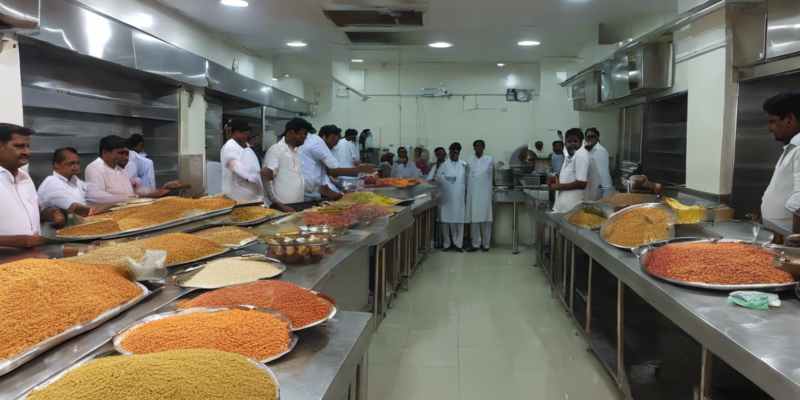Rajasthan, a state in northern India, is renowned for its rich cultural heritage, vibrant traditions, and of course, its delectable cuisine. The gastronomic scene of Rajasthan is a culinary delight that reflects the royal legacy of the state, with a myriad of flavors, spices, and cooking techniques that have been passed down through generations. In this article, we will take a deep dive into Rajasthan’s food department and explore the unique dishes, ingredients, and culinary traditions that make this region a paradise for food enthusiasts.
Traditional Rajasthani Cuisine
Rajasthani cuisine is as colorful and diverse as the state itself, offering a blend of flavors that are both spicy and savory. The use of indigenous ingredients such as millet, gram flour, and various spices gives Rajasthani dishes their unique taste and texture. The traditional cooking methods, including slow cooking over charcoal fires and the use of clay pots, add a distinct flavor profile to the dishes.
Must-try Dishes
-
Dal Baati Churma: This iconic Rajasthani dish consists of baked wheat balls (baati) served with lentils (dal) and a sweet crumbled mixture (churma). The combination of flavors and textures in this dish is a true culinary delight.
-
Gatte ki Sabzi: Gram flour dumplings (gatte) cooked in a spicy yogurt-based curry, this dish is a staple in Rajasthani households and is often served with rice or roti.
-
Laal Maas: A fiery red mutton curry prepared with a special blend of Rajasthani spices, this dish is a favorite among meat lovers and is best enjoyed with bajra roti.
-
Ker Sangri: A traditional Rajasthani delicacy made from ker berries and sangri beans, this dish is a perfect example of the region’s ingenious use of local ingredients.
Signature Flavors and Spices
Rajasthani cuisine is characterized by its bold flavors and aromatic spices that lend depth and richness to the dishes. Some of the signature spices used in Rajasthani cooking include cumin seeds, coriander powder, red chili powder, and asafoetida. These spices not only add heat and pungency but also enhance the overall flavor profile of the dishes.
Desert Specialties
-
Mirchi Vada: A popular street food snack in Rajasthan, mirchi vada is a spicy chili pepper stuffed with a potato filling, coated in gram flour batter, and deep-fried until crispy.
-
Pyaz Kachori: Crispy deep-fried pastries stuffed with a spicy onion filling, pyaz kachori is a beloved snack in Rajasthan that is often enjoyed with tamarind chutney.
-
Ghevar: A traditional Rajasthani sweet prepared during festivals like Teej and Raksha Bandhan, ghevar is a disc-shaped sweet made from flour, ghee, and sugar syrup.
Dining Customs and Etiquette
In Rajasthan, dining is not just about eating food; it is a cultural experience that reflects hospitality and warmth. Traditional Rajasthani meals are served in thalis (large metal platters) and often include a variety of dishes to cater to different taste preferences. Eating with hands is a common practice in Rajasthan, as it is believed to enhance the dining experience and bring the eater closer to the food.
Festive Feasts
-
Dal Bati Churma: A traditional festive meal in Rajasthan, dal bati churma is served with ghee, jaggery, and a side of buttermilk or lassi.
-
Rajasthani Thali: A colorful spread of curries, vegetables, bread, rice, and sweets, the Rajasthani thali is a grand feast that offers a taste of the region’s culinary heritage.
-
Mawa Kachori: A rich and decadent dessert kachori filled with sweetened mawa (khoya) and dry fruits, mawa kachori is a must-try during festivals like Diwali.
Sustainable Food Practices
Rajasthan has a strong tradition of sustainable food practices that have been ingrained in the culture for centuries. The use of locally sourced ingredients, seasonal produce, and efficient cooking techniques are some of the key aspects of sustainable food practices in the region. The emphasis on minimizing food waste and utilizing every part of the ingredients reflects the resourcefulness of Rajasthani cuisine.
Eco-friendly Choices
-
Bajra and Millet: Staple grains like bajra and millet are not only nutritious but also eco-friendly, requiring less water and resources to grow compared to other grains.
-
Locally Sourced Produce: By sourcing ingredients from local farmers and markets, Rajasthani cuisine supports small-scale producers and reduces the carbon footprint associated with transportation.
-
Zero Waste Cooking: Many Rajasthani dishes are designed to minimize food waste by using every part of the ingredient, whether it’s the stems, leaves, or peels.
Culinary Influences and Innovations
While traditional Rajasthani cuisine forms the backbone of the region’s culinary identity, modern influences and innovations have also made their mark on the food scene. Fusion dishes that combine Rajasthani flavors with global ingredients, as well as innovative cooking techniques, are gaining popularity in upscale restaurants and cafes across the state.
Fusion Creations
-
Rajasthani Tacos: A fusion dish that replaces traditional taco fillings with Rajasthani curries and chutneys, Rajasthani tacos offer a new twist on classic street food.
-
Ker Sangri Pizza: A creative take on the Italian classic, ker sangri pizza features a topping of the traditional Rajasthani ker sangri vegetable mix on a crispy pizza base.
-
Gatte Pasta: Gatte, the gram flour dumplings, are reinvented in this fusion dish where they are served with pasta in a creamy Rajasthani curry sauce.
Frequently Asked Questions (FAQs)
- What are some common ingredients used in Rajasthani cuisine?
-
Common ingredients in Rajasthani cuisine include gram flour, millet, ker berries, sangri beans, and a variety of spices such as cumin, coriander, and red chili powder.
-
Is Rajasthani food very spicy?
-
Rajasthani food is known for its bold and spicy flavors, although the level of spiciness can be adjusted according to personal preferences.
-
What are some popular Rajasthani sweets and desserts?
-
Popular Rajasthani sweets and desserts include ghevar, mawa kachori, malpua, and balushahi.
-
Are there vegetarian options available in Rajasthani cuisine?
-
Yes, Rajasthani cuisine offers a wide range of vegetarian options including dal bati churma, gatte ki sabzi, ker sangri, and more.
-
What is the significance of eating with hands in Rajasthan?
-
Eating with hands is believed to enhance the sensory experience of dining and establish a direct connection with the food, according to traditional customs in Rajasthan.
-
How can I experience authentic Rajasthani cuisine in Rajasthan?
-
To experience authentic Rajasthani cuisine, visit local eateries, street food stalls, and heritage hotels that offer traditional Rajasthani dishes made with local ingredients and cooking techniques.
-
Are there any food festivals or events in Rajasthan that celebrate the local cuisine?
-
Rajasthan hosts several food festivals and events throughout the year, such as the Jaipur Literature Festival, which features a food court with an array of Rajasthani delicacies.
-
What makes Rajasthani cuisine unique compared to other regional cuisines in India?
-
Rajasthani cuisine is unique for its robust flavors, use of indigenous ingredients, and traditional cooking methods that have been preserved over generations, showcasing the rich culinary heritage of the region.
-
Can I find Rajasthani food outside of Rajasthan, in other parts of India or internationally?
-
Yes, Rajasthani cuisine has gained popularity across India and internationally, with many restaurants offering Rajasthani dishes on their menus. Additionally, food festivals and cultural events often feature Rajasthani food stalls.
-
How can I recreate Rajasthani dishes at home if I don’t have access to all the local ingredients?
- While some ingredients may be specific to Rajasthan, many Rajasthani dishes can be recreated using common substitutes or by sourcing similar ingredients locally. Experimenting with spices and flavors can also help capture the essence of Rajasthani cuisine in home-cooked meals.
In conclusion, exploring Rajasthan’s food department is more than just a culinary journey; it’s a cultural immersion into a world of flavors, traditions, and sustainable practices that define the region’s rich gastronomic heritage. From traditional delicacies like dal baati churma and gatte ki sabzi to modern fusion creations, Rajasthan’s culinary scene offers a delightful experience for food enthusiasts seeking to savor the essence of this vibrant state.


